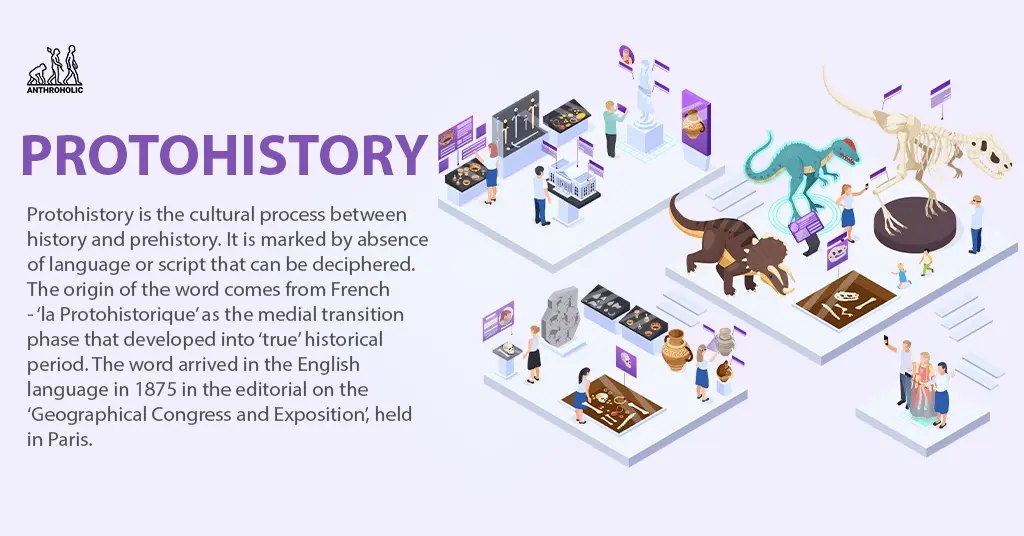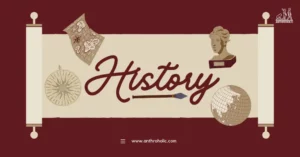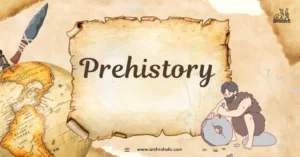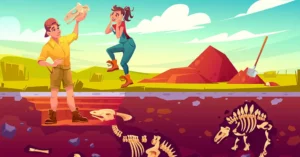Protohistory
Protohistory is the cultural process between history and prehistory. It is marked by absence of language or script that can be deciphered. The origin of the word comes from French – ‘la Protohistorique’ as the medial transition phase that developed into ‘true’ historical period. The word arrived in the English language in 1875 in the editorial on the ‘Geographical Congress and Exposition’, held in Paris.[1]

Oftentimes oral as well as some written language is present in such protohistoric cultures but it has either become redundant or hasn’t been successfully interpreted by modern scholars. The evidence of such phases comes archaeologically through pottery, metallurgy and settlement patterns. John K. Papadopoulous has described protohistory as a ‘term applied to peoples that never recorded their own history’. As a result, earliest proto-historical literature comes from Classical Greece and Rome, who documented the lifestyles of non-literate European societies that they encountered.
Classification
It is widely accepted that protohistory can encompass Chalcolithic, Bronze age and Iron age as it is easier to classify cultures based on materiality when linguistic knowledge is scanty. Additionally, there are a lot of overlaps when it comes to proto historical classification. For example, according to H.D. Sankalia the various chalcolithic cultures in India were contemporaneous to the Bronze age Indus Valley Civilization[2]. As such, the presence of language, peculiar artifacts and lifestyles must all be considered for a reasonable classification.
Identification
Technological development can be a good marker for the beginning of prehistoric cultures. Generally assemblages include a mixture of metal and lithic artifacts. Pottery styles can be essential in relatively placing cultures in the proto historical phase. For example in India, the Painted Grey Ware (PGW) and Ochre Coloured Pottery of Harappan Civilization demonstrates this phase.
Moreover, architectural and infrastructural aspects can also be considered as viable means of identification. Generally burnt brick and clay construction along with intricate drainage systems are found. Trade connections are also found between protohistoric cultures, examples include Indus Valley Civilization and Middle Eastern societies as well as between Koreanic Iron culture kingdoms and ancient Japan during the 2nd century BCE.[3]
Protohistoric cultures also include well-formed administration and social structure as found in Indus and other Germanic tribes. As many of these regions belong to well-developed ancient traditions and cultures such as in China, Japan, Mesopotamia etc. The occurrence of religion and worship is also present through evidence of shrines, deified figurines and symbolic seals and iconography.
Dating and Variation
Considering the overlaps and variation is crucial in understanding how protohistoric cultures are placed in the timescale. In the global context, proto-history occurs at different stages in different regions in relation to its commencement and culmination. In India, it spans from 3000 to 600 BCE encapsulating chalcolithic and bronze ages[4]. In other parts of the world like the USA, protohistory has been recorded to a much later period of 1500 CE[5].This happens because different cultures in different regions developed at varying rates and experienced acculturation at different times hence, the occurrence of protohistory in a region is perhaps subjective and importantly relative to that region.
Conclusion
As we can ascertain, the concept of protohistory is complicated and subject to various issues. Literacy or writing systems cannot be the sole provisionary factors in classifying protohistory. Material culture is just as important in doing the same. Scholars give examples of Egyptian and Sumerian cultures where language developed much earlier and had oral traditions as well as historical materiality[1]. Additionally, the use of the term suggests a linear perspective about development of cultures from non-textual and oral to absolutely textual and speech-oriented. Today, such assumptions are avoided by scholars altogether, let alone hypothesized.
See Also
References
[1] John K. Papadopoulos (2018) Greek protohistories, World Archaeology, 50:5, 690-705, DOI: 10.1080/00438243.2019.1568294
[2] Sankalia, H. D. (1974). The prehistory and protohistory of India and Pakistan. Poona : Deccan College, Postgraduate and Research Institute
[3]Cartwright, M. (2016, November 25). Ancient Korean & Japanese Relations. World History Encyclopedia. Retrieved from https://www.worldhistory.org/article/982/ancient-korean–japanese-relations/
[4] Dhavalikar, M. K. (1997). Indian protohistory. Books & Books.
[5] McEwan, B. G. (Ed.). (2000). Indians of the Greater Southeast: Historical Archaeology and Ethnohistory. University Press of Florida.



